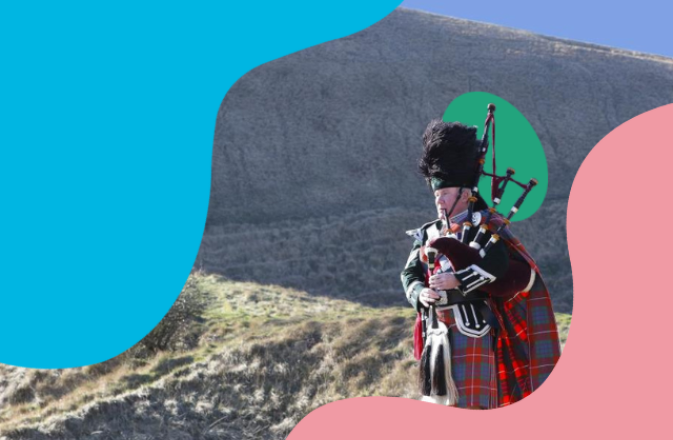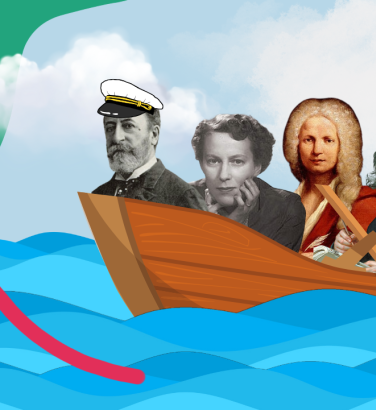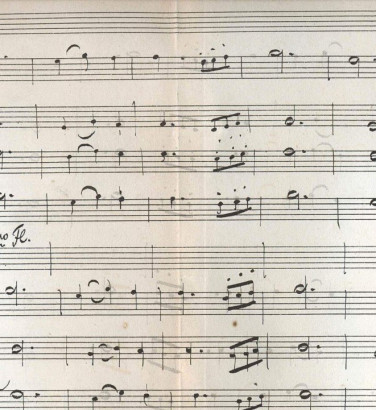
Two centuries of musical sunrises
19 Feb 2024
News Story
Detail from the cover of the SCO's 2016 recording of Maxwell Davies' An Orkney Wedding, with Sunrise
Who but a Scottish composer would consider using the bagpipes to depict the rising sun? Peter Maxwell Davies’ 1985 work An Orkney Wedding, with Sunrise (which the Orchestra performs at the Brno International Music Festival on 23 September) actually follows in a long tradition of musical portrayals of dawn.
This is an example of programme music, in which anything from a still image to an entire narrative can be conveyed through the medium of music. Although the phenomenon truly took off in the 19th century, minor instances can be found much earlier, particularly in vocal music. Any mention of sighing could gain an extra dimension by being set to a falling figure, or taking things a little further, Purcell illustrates the words ‘he cometh up and is cut down’ (in his 1682 anthem Man that is born of a woman) with a scale that rises before coming back down.
A slow rising scale is precisely what Haydn turned to for depicting the very first sunrise in his oratorio The Creation (1797-98): opening with a quiet single note in the flute and first violins, it moves up steadily as more instruments are heard, adding volume, splendour and ever richer harmonies until the trumpets and timpani join in, adding to a resounding fortissimo. The whole process might take about 30 seconds, but is one of the most memorable parts of the entire score, and an extension of a similar passage at the opening of his Symphony No 6, known as Le matin (Morning) on this account. Haydn clearly knew he was on to a good thing, repeating the process in The Seasons (1800-01), only with voices as well: if it proves less memorable than The Creation’s sunrise, this can be put down to the later work’s lesser status in general and (arguably) there being more original touches elsewhere in the score.
That said, it’s a little surprising that Haydn appears to have been the exception when including sunrise among his musical depictions of nature: Vivaldi’s Four Seasons (1718-20) and Beethoven’s Symphony No 6 (Pastoral, 1808), despite being richly evocative of the natural world, both leave it out. Even Knecht’s now little-known Portrait musical de la nature (Musical portrait of nature, 1785) opens on ‘une belle contrée où le soleil luit’ (‘a beautiful landscape where the sun shines’), i.e. long after dawn.
Programme music really came into its own following the success of Berlioz’ Symphonie fantastique (1830), and if this work didn’t depict sunrise either – its only representation of the natural world is in the third movement’s distant thunder – it showed the path to many other composers. That said, it would not be until 1875 that one of the most-recognised musical sunrises would come into being, in Grieg’s incidental music to Ibsen’s Peer Gynt. The title by which this movement is generally known – Morning Mood – is actually truncated, leaving out the key phrase ‘in the desert’. This gently rocking pastorale has conjured up mental images of the Norwegian fjords in the minds of audiences ever since, but in the context of the play, it finds the title character not in Scandinavia but Morocco, one of many far-off places which Peer visits on the course of his (mis)adventures.
As far as contemporary culture goes, the musical sunrise to end all musical sunrises is from Strauss’ Also sprach Zarathustra (1896), thanks largely to Stanley Kubrick’s epic 2001: A Space Odyssey (1968). The music – taking up barely two minutes of a work which lasts a good half-hour – opens with a low rumble over which the brass lead a series of fanfares, culminating in a gigantic held chord on the organ. The score is not especially groundbreaking (at least at this stage), but no-one would deny it is fantastically effective.
Some consider the gloriously expansive sunrise in Strauss' Alpine Symphony (1911-15) even better, but it lacks the ubiquity of Also sprach Zarathustra's opening, which now serves as shorthand for creating a sense of anticipation far beyond sunrise. Aardman (creators of the Wallace and Gromit series) put it to comic use - rescoring the music for accordion, two bongos and a crash cymbal - in their 2012 film The Pirates!, In an Adventure with Scientists!, as the titular miscreants reveal the existence of a dodo to a Victorian science convention.
Over in France, the Impressionists' approach in depicting the rising sun eschewed late Romantic grandeur in favour of a more subtle approach. Debussy considered it from a purely maritime perspective in the first movement of La mer (The sea, 1903-05), portraying the period ‘From dawn to noon on the waves’, but he is more interested in the movement of the waters than shifting light (as is Britten in the first of the Sea Interludes from his 1945 opera Peter Grimes). For a true portrayal of sunrise, we need look no further than Ravel’s Daphnis et Chloé (1912): a shimmer of woodwind glides over a slowly-evolving bass line, with the occasional tweeting bird and piping shepherd adding to the atmosphere as the skies gradually lighten.
Maxwell Davies’ approach harkens back to simpler times, but retains many of the qualities which made these earlier pieces stand out: the slow build to the bagpipes’ entry owes something to both Haydn and Ravel, giving way to a folksong-like atmosphere Grieg would have appreciated, with more than a touch of Straussian scale. From a Scottish perspective, the fact this sunrise is over Caithness is the icing on the cake.
Related Stories
![]()
Making a splash: water music beyond Handel
5 January 2026
We take a look at musical depictions of water, from trickling burns to the wide expanse of the ocean, to see what lurks below the surface.![]()
Mozart and the symphony
22 December 2025
Stuck between the symphonies of Haydn and Beethoven, where do Mozart's fit in?![]()
Unfinished symphonies
15 December 2025
Your starter for ten: besides Schubert, who has an unfinished symphony to their name?



